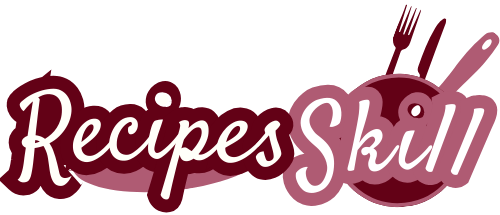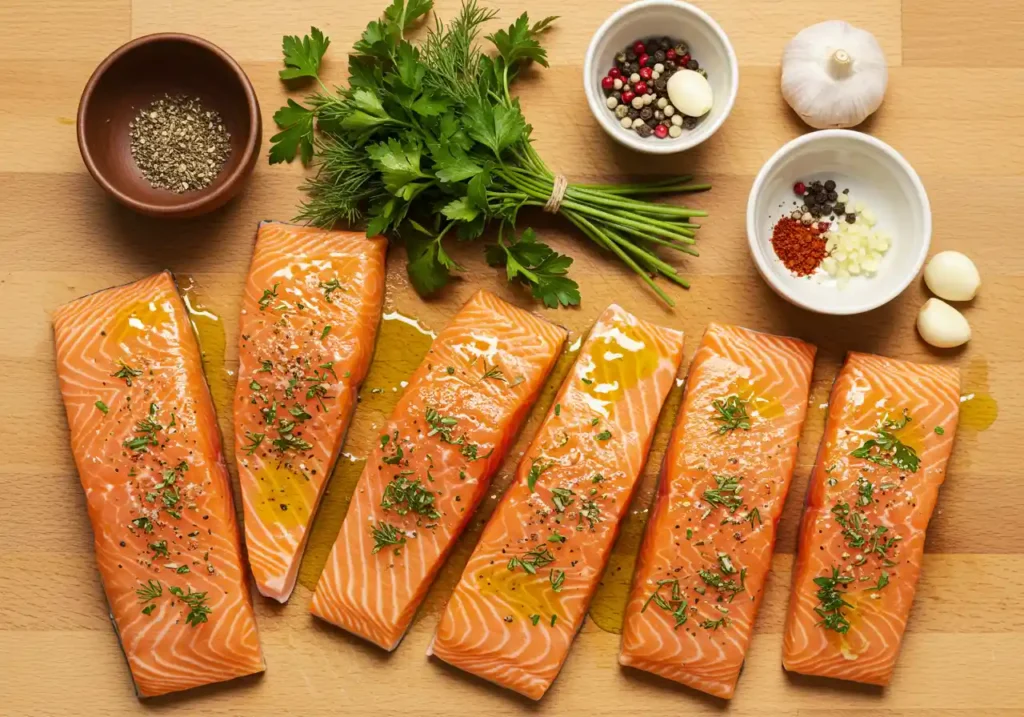Are you looking for a simple yet scrumptious way to prepare salmon? Look no further! This article will guide you through the ins and outs of a baked salmon recipe that’s not only easy to follow but also packed with flavor and nutrition. Whether you’re a seasoned chef or a kitchen novice, you’ll find tips and tricks to make your salmon dish shine. From selecting the freshest ingredients to serving suggestions, we’ve got you covered. So, let’s dive into the world of baked salmon!
Baking salmon to perfection is all about locking in flavor and moisture. For consistently tender and flavorful proteins, try incorporating simple cooking hacks to retain moisture in proteins into your routine. Whether you’re preparing salmon or learning how to cook chicken like a chef, these tips can make a world of difference. Pair this baked salmon with other delicious oven-baked meals for dinner for a wholesome and satisfying spread!
Introduction to Baked Salmon
When we talk about baked salmon, we’re referring to a cooking method that involves placing salmon fillets in the oven until they’re perfectly cooked. This technique allows the fish to retain its natural moisture, resulting in a tender and flaky texture. Baked salmon is not just a dish; it’s a culinary experience that brings out the rich flavors of this beloved fish.
Why Choose Baked Salmon?
You might wonder, why should I choose baked salmon over other cooking methods? Well, for starters, it’s incredibly healthy! Salmon is loaded with omega-3 fatty acids, which are essential for heart health. Plus, it’s a fantastic source of protein, vitamins, and minerals. When you bake salmon, you’re not only preserving its nutritional value but also enhancing its flavor without the need for excessive oils or fats.
In comparison to frying or grilling, baking is a gentler method that allows the fish to cook evenly. This means you’re less likely to end up with dry or overcooked salmon. So, if you’re aiming for a healthy dinner that doesn’t skimp on taste, baked salmon is the way to go!
In this article, we’ll walk you through everything you need to know about preparing a mouthwatering baked salmon recipe. We’ll cover the essential ingredients, preparation steps, baking techniques, and even some creative variations to keep things exciting. Plus, we’ll answer some frequently asked questions to ensure you have all the information you need to make the perfect dish. So, let’s get started on this culinary journey!
Ingredients for Baked Salmon
Essential Ingredients
To whip up a delightful baked salmon recipe, you’ll need a few essential ingredients. Here’s what you should gather:
- Fresh Salmon Fillets: The star of the show! Look for fillets that are bright in color and have a fresh smell. Wild-caught salmon is often preferred for its rich flavor, but farmed salmon can also be a great choice.
- Olive Oil: A drizzle of high-quality olive oil not only adds flavor but also helps keep the salmon moist during baking.
- Salt and Pepper: Simple yet effective, these seasonings enhance the natural taste of the salmon.
Optional Ingredients
While the essential ingredients are a must, you can elevate your baked salmon with some optional additions:
- Herbs: Fresh herbs like dill, parsley, or thyme can add a burst of flavor. They pair beautifully with salmon and can be sprinkled on top before baking.
- Lemon Slices: A few slices of lemon can brighten up the dish, adding a zesty kick that complements the fish perfectly.
- Garlic: Minced garlic can infuse the salmon with a savory aroma and taste.
- Other Seasonings: Feel free to experiment with spices like paprika or cayenne for a little heat.
Choosing the Right Salmon
Selecting the right salmon is crucial for a successful baked salmon recipe. Here are some tips to help you make the best choice:
- Types of Salmon: There are several types of salmon available, including sockeye, coho, and king salmon. Each has its unique flavor and texture. Sockeye is known for its deep red color and rich taste, while king salmon is prized for its high-fat content and buttery texture.
- Freshness: Always opt for the freshest salmon you can find. Look for fillets that are firm to the touch and have a bright, shiny appearance. If you’re unsure, don’t hesitate to ask your fishmonger for advice.
- Sustainability: Consider choosing sustainably sourced salmon. Resources like Seafood Watch can help you make informed decisions about the seafood you buy.
With the right ingredients in hand, you’re well on your way to creating a delicious baked salmon recipe.
Preparation Steps for Baked Salmon
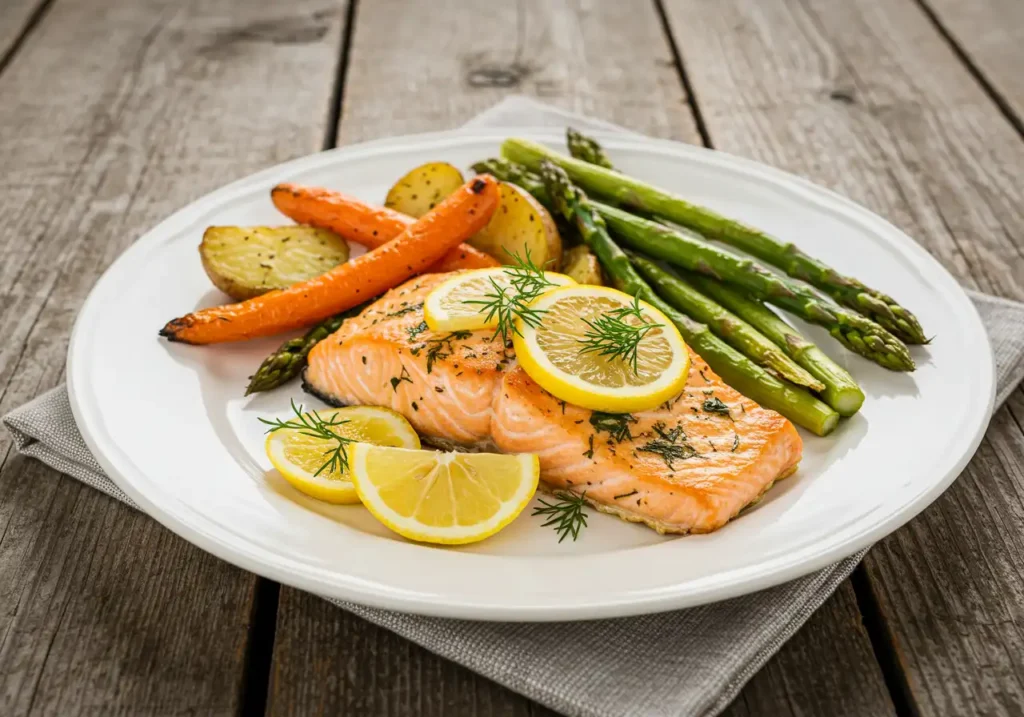
1. Prepping the Salmon
Before you start baking, it’s essential to prep your salmon properly. Here’s how to do it:
- Cleaning the Fillets: Rinse the salmon fillets under cold water to remove any residual scales or debris. Pat them dry with paper towels. This step is crucial because excess moisture can prevent the salmon from baking evenly.
- Marinating Options: While salmon is delicious on its own, marinating can add an extra layer of flavor. You can create a simple marinade using olive oil, lemon juice, minced garlic, and your choice of herbs. Let the salmon marinate for about 15-30 minutes for the best results.
2. Preparing the Baking Dish
Choosing the right baking dish is key to achieving perfectly baked salmon. Here’s what to consider:
- Choosing the Right Dish: A glass or ceramic baking dish works well for salmon. If you prefer, you can also use a baking sheet lined with parchment paper for easy cleanup.
- Greasing and Lining the Dish: Lightly grease the baking dish with olive oil or cooking spray to prevent sticking. If you’re using parchment paper, place it in the dish, allowing some overhang for easy removal later.
3. Seasoning the Salmon
Now that your salmon is prepped, it’s time to season it to perfection:
- How to Season Effectively: Place the salmon fillets skin-side down in the baking dish. Drizzle olive oil over the top, then sprinkle with salt and pepper. If you’re using herbs or garlic, now’s the time to add them. For a touch of brightness, lay lemon slices on top of the fillets.
- Tips for Flavor Enhancement: Don’t be shy with the seasonings! A generous sprinkle of herbs can make a world of difference. If you’re feeling adventurous, try adding a pinch of red pepper flakes for a bit of heat.
4. Preheating the Oven
Preheating your oven is a crucial step that shouldn’t be overlooked:
- Importance of Preheating: Preheating ensures that your salmon cooks evenly from the start. If you place it in a cold oven, you risk uneven cooking and a less-than-ideal texture.
- Recommended Temperature for Baking Salmon: Set your oven to 400°F (200°C). This temperature is perfect for achieving a beautifully baked salmon with a crispy exterior and tender interior.
With your salmon prepped, seasoned, and the oven preheated, you’re ready to move on to the baking process
Baking the Salmon
Baking Techniques
Now that your salmon is prepped and ready, it’s time to get it into the oven! Here are some effective baking techniques to consider:
- How to Bake Salmon in the Oven: Place the baking dish with the seasoned salmon in the preheated oven. Bake for about 12-15 minutes, depending on the thickness of the fillets. A general rule of thumb is to bake for about 4-6 minutes per half-inch of thickness.
- Alternative Methods: If you want to try something different, consider wrapping the salmon in foil. This method helps to lock in moisture and flavor. Simply place the seasoned salmon on a piece of aluminum foil, fold the edges to create a sealed packet, and bake. You can also bake the salmon on a bed of vegetables, like asparagus or zucchini, for a complete meal in one dish.
Cooking Time and Temperature
Getting the cooking time and temperature right is crucial for perfectly baked salmon:
- Recommended Baking Times Based on Thickness: As mentioned earlier, the thickness of your salmon fillets will determine how long they need to bake. For fillets that are about 1 inch thick, aim for 12-15 minutes. If your fillets are thicker, you may need to add a few extra minutes.
- How to Check for Doneness: The best way to check if your salmon is done is to use a fork. Gently flake the salmon at the thickest part; if it flakes easily and is opaque, it’s ready to come out of the oven. Alternatively, you can use a meat thermometer to check for an internal temperature of 145°F (63°C).
Tips for Perfectly Baked Salmon
To ensure your baked salmon turns out perfectly every time, keep these tips in mind:
- Avoiding Common Mistakes: One common mistake is overcooking the salmon. Keep a close eye on it as it bakes, and remember that it will continue to cook slightly after you take it out of the oven.
- How to Achieve a Crispy Skin: If you prefer crispy skin, bake the salmon skin-side down and increase the oven temperature to 425°F (220°C) for the last few minutes of cooking. This will help crisp up the skin without drying out the fish.
Serving Suggestions
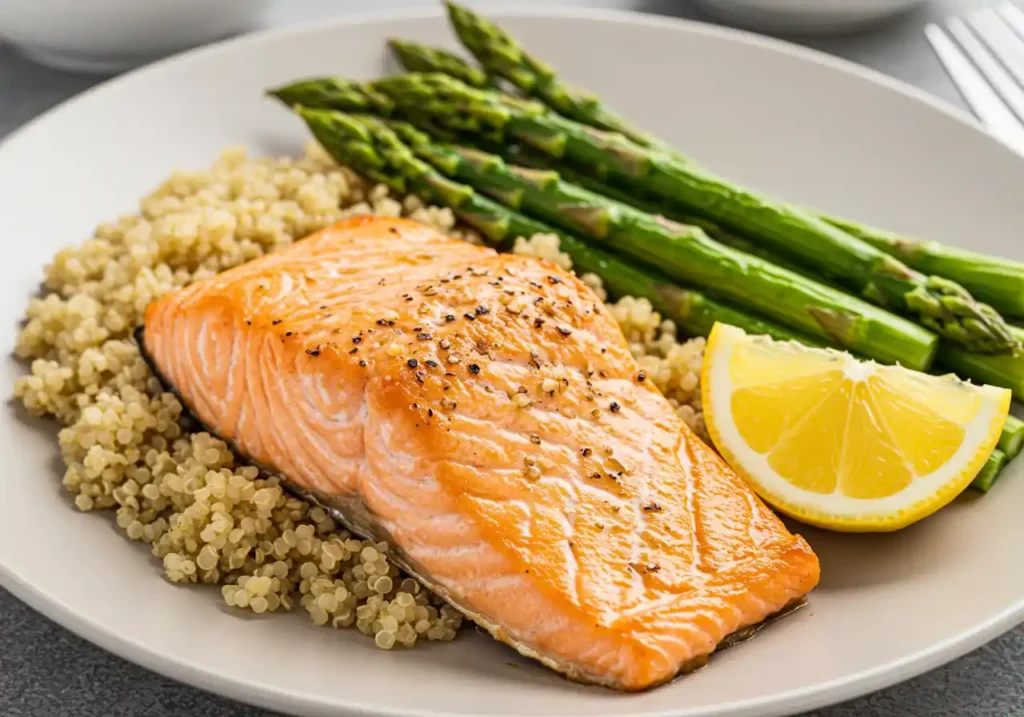
1. Side Dishes to Pair with Baked Salmon
When it comes to serving your baked salmon, the right side dishes can elevate the meal to a whole new level. Here are some fantastic options to consider:
- Vegetables: Roasted or steamed vegetables are a perfect complement to salmon. Consider serving your salmon with asparagus, broccoli, or green beans. These veggies not only add color to your plate but also provide a healthy balance to the meal. You can toss them in olive oil, salt, and pepper, and roast them in the oven alongside the salmon for a convenient one-pan meal.
- Grains: Pairing your salmon with grains can make for a hearty and satisfying dinner. Quinoa, brown rice, or couscous are excellent choices. They absorb flavors well and can be seasoned to match your salmon. For a twist, try adding herbs or lemon zest to your grains for an extra burst of flavor.
2. Sauces and Condiments
While baked salmon is delicious on its own, a tasty sauce or condiment can take it to the next level:
- Lemon Butter Sauce: A simple lemon butter sauce can enhance the flavors of your salmon beautifully. Just melt some butter, add fresh lemon juice, and whisk until combined. Drizzle it over the salmon just before serving for a zesty finish.
- Tartar Sauce: If you enjoy a creamy accompaniment, homemade tartar sauce is a classic choice. Mix mayonnaise, chopped pickles, capers, and a squeeze of lemon juice for a tangy dip that pairs wonderfully with salmon.
3. Presentation Tips
Presentation is key when serving your baked salmon. Here are some tips to make your dish visually appealing:
- Plating Ideas: Place the salmon fillet on a bed of grains or alongside your roasted vegetables. This not only looks beautiful but also creates a balanced plate.
- Garnishing with Herbs and Lemon: A sprinkle of fresh herbs, like parsley or dill, can add a pop of color. Additionally, a few lemon wedges on the side not only look great but also allow your guests to add a splash of citrus if they desire.
With your baked salmon beautifully plated and paired with delicious sides, it’s time to dig in! But wait there are so many ways to enjoy this dish.
Variations of Baked Salmon
Different Flavor Profiles
One of the best things about baked salmon is its versatility. You can easily switch up the flavors to suit your taste or the occasion. Here are some ideas to inspire you:
- Asian-Inspired: For a delightful twist, try marinating your salmon in a mixture of soy sauce, ginger, and sesame oil. This combination adds a savory depth that pairs beautifully with the natural flavors of the fish. You can also sprinkle sesame seeds on top before baking for added texture.
- Mediterranean: If you’re in the mood for something fresh and vibrant, consider a Mediterranean approach. Top your salmon with crumbled feta cheese, olives, and sun-dried tomatoes. Drizzle with olive oil and a splash of balsamic vinegar before baking. This combination will transport your taste buds to the sunny shores of the Mediterranean!
Cooking with Different Ingredients
Don’t hesitate to get creative with your baked salmon recipe by incorporating different ingredients:
- Adding Vegetables: You can bake your salmon on a bed of vegetables for a complete meal. Try using sliced bell peppers, zucchini, or cherry tomatoes. Not only do they add flavor, but they also create a colorful presentation.
- Using Different Oils and Spices: Experiment with flavored oils, such as avocado or garlic-infused olive oil, to add a unique twist. Additionally, spices like cumin or coriander can bring a warm, earthy flavor to your salmon.
Baked Salmon in Different Cuisines
Why not explore global flavors with your baked salmon? Here are a few ideas:
- Indian-Inspired: Marinate your salmon in a mixture of yogurt, turmeric, cumin, and garam masala for a fragrant and flavorful dish. Serve it with basmati rice and a side of cucumber raita for a refreshing contrast.
- Latin American: For a zesty kick, try a marinade made with lime juice, cilantro, and chili powder. This bright flavor profile pairs wonderfully with a side of black beans and corn salad.
Storing and Reheating Baked Salmon
How to Store Leftover Salmon
If you find yourself with leftover baked salmon, don’t worry! Proper storage will keep it fresh and delicious for your next meal. Here’s how to do it:
- Best Practices for Refrigeration: Allow the salmon to cool to room temperature before storing it. Place the leftover salmon in an airtight container or wrap it tightly in plastic wrap. It’s best to consume refrigerated salmon within 3-4 days to ensure optimal freshness.
- Freezing Options: If you want to keep your salmon for a longer period, freezing is a great option. Wrap the salmon tightly in aluminum foil or plastic wrap, then place it in a freezer-safe bag. Make sure to label the bag with the date. Frozen salmon can last for up to 2-3 months. When you’re ready to enjoy it again, simply thaw it in the refrigerator overnight.
Reheating Techniques
Reheating your baked salmon properly is key to maintaining its flavor and texture. Here are some effective methods:
- Best Methods to Retain Moisture and Flavor: The best way to reheat salmon is in the oven. Preheat your oven to 275°F (135°C). Place the salmon on a baking sheet and cover it loosely with aluminum foil to prevent it from drying out. Heat for about 15-20 minutes, or until warmed through.
- Microwave Option: If you’re short on time, you can use the microwave. Place the salmon on a microwave-safe plate and cover it with a damp paper towel. Heat in short intervals of 30 seconds, checking frequently to avoid overcooking. While this method is quick, it may not yield the same texture as oven reheating.
FAQs about Baked Salmon Recipe
Common Questions
As you embark on your journey to create the perfect baked salmon recipe, you might have some questions. Here are answers to some of the most frequently asked questions:
1. How long to bake salmon at 400°F?
Generally, you should bake salmon at 400°F (200°C) for about 12-15 minutes, depending on the thickness of the fillets. A good rule of thumb is to bake for 4-6 minutes per half-inch of thickness. Always check for doneness by flaking the fish with a fork.
2. Can you bake salmon from frozen?
Yes, you can bake salmon from frozen! However, it’s best to thaw it first for even cooking. If you’re in a pinch, you can bake it directly from frozen, but you’ll need to increase the cooking time by about 50%. Make sure to check for doneness before serving.
3. What is the best way to tell if salmon is done?
The best way to check if your salmon is done is to use a fork to gently flake the thickest part of the fillet. If it flakes easily and appears opaque, it’s ready to eat. Alternatively, you can use a meat thermometer to check for an internal temperature of 145°F (63°C).
Additional Tips
Here are a few more tips to help you achieve the best results with your baked salmon:
1. How to avoid dry salmon?
To prevent dry salmon, avoid overcooking it. Keep an eye on the cooking time and check for doneness a few minutes before the recommended time. Additionally, using a marinade or topping the salmon with oil or butter can help retain moisture.
2. Can you use skin-on salmon for baking?
Absolutely! Skin-on salmon can be baked just like skinless fillets. The skin helps to keep the fish moist during cooking and can become crispy if baked properly. Just remember to place the salmon skin-side down in the baking dish.
Conclusion
Throughout this article, we’ve explored the wonderful world of baked salmon. From understanding what makes this dish so special to selecting the right ingredients and mastering the baking process, you now have all the tools you need to create a delicious meal. We’ve discussed various flavor profiles, side dishes, and even how to store and reheat leftovers, ensuring that you can enjoy your salmon in multiple ways.
Now it’s your turn! Don’t hesitate to experiment with the tips and variations we’ve shared. Whether you stick to the classic recipe or venture into new flavor territories, baked salmon is a versatile dish that can fit any occasion. So, gather your ingredients, preheat that oven, and get ready to impress your family and friends with a delightful meal that’s both healthy and satisfying. Happy cooking!
Print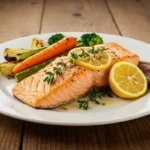
Baked Salmon Recipe: A Delicious and Healthy Delight
- Total Time: 25 minutes
- Yield: 4 servings 1x
- Diet: Gluten Free
Description
This Baked Salmon Recipe is not only easy to prepare but also packed with flavor and nutrients. Perfect for a weeknight dinner or a special occasion, it’s sure to impress your family and friends!
Ingredients
-
For the Salmon:
- 4 salmon fillets (about 6 ounces each)
- 2 tablespoons olive oil
- 1 teaspoon salt
- 1/2 teaspoon black pepper
- 2 tablespoons fresh dill (or 1 tablespoon dried dill)
- 1 lemon, sliced
- 2 cloves garlic, minced (optional)
-
For Serving:
- Fresh parsley, chopped (for garnish)
- Lemon wedges (for serving)
Instructions
-
Preheat the Oven:
- Preheat your oven to 400°F (200°C).
-
Prepare the Baking Dish:
- Lightly grease a baking dish with olive oil or line it with parchment paper for easy cleanup.
-
Season the Salmon:
- Place the salmon fillets skin-side down in the prepared baking dish.
- Drizzle olive oil over the fillets, ensuring they are well coated.
- Sprinkle salt, black pepper, and dill evenly over the salmon.
- If using, add minced garlic on top of the fillets for extra flavor.
- Lay lemon slices on top of each fillet.
-
Bake the Salmon:
- Place the baking dish in the preheated oven.
- Bake for 12-15 minutes, or until the salmon flakes easily with a fork and reaches an internal temperature of 145°F (63°C).
-
Garnish and Serve:
- Once baked, remove the salmon from the oven and let it rest for a couple of minutes.
- Garnish with fresh parsley and serve with lemon wedges on the side.
Notes
Choosing Salmon: Opt for wild-caught salmon for the best flavor and nutritional benefits. Look for fillets that are bright in color and have a fresh smell.
Storage: Leftover salmon can be stored in an airtight container in the refrigerator for up to 3-4 days. Reheat gently in the oven or microwave.
Serving Suggestions: This baked salmon pairs well with roasted vegetables, quinoa, or a fresh salad for a complete meal.
- Prep Time: 10 minutes
- Cook Time: 15 minutes
- Category: Main Dish
- Method: Baking
- Cuisine: American
Nutrition
- Serving Size: 1 salmon fillet (approximately 6 ounces)
- Calories: 350
- Sugar: 0g
- Sodium: 600mg
- Fat: 20g
- Saturated Fat: 4g
- Unsaturated Fat: 14g
- Trans Fat: 0g
- Carbohydrates: 2g
- Fiber: 0g
- Protein: 34g
- Cholesterol: 90mg
Keywords: Baked salmon dish, oven-baked salmon, salmon fillet recipe, Baked Salmon
